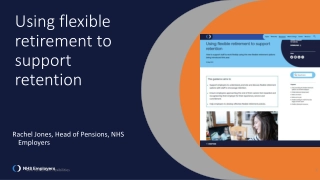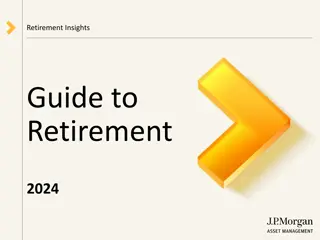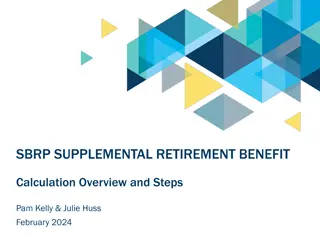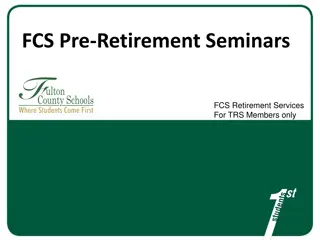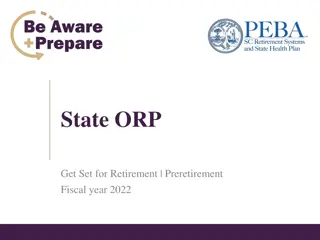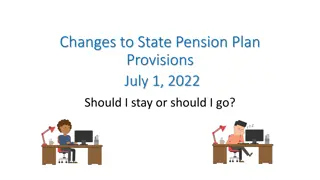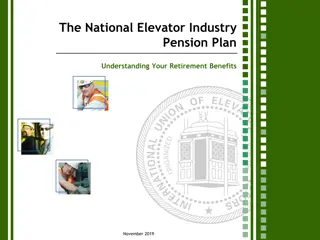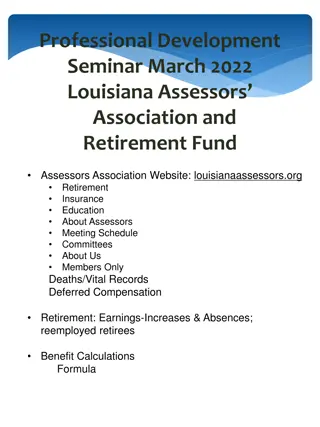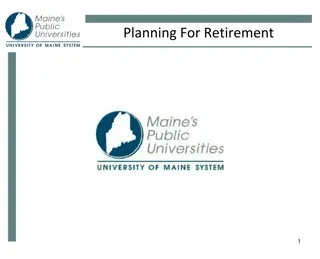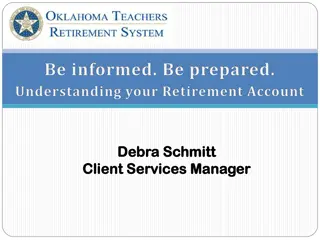Decoding Social Security for Retirement Planning
Discover the origins, importance, and future challenges of Social Security, along with strategies for maximizing benefits during retirement. Explore key aspects such as the Pay-As-You-Go system, changing demographics, and the Social Security Trust Fund. Gain insights on drawing from different financial buckets and learn from historical figures like Ida J. Fuller. Dive into the fundamentals of Social Security and its impact on retirement income security.
Download Presentation

Please find below an Image/Link to download the presentation.
The content on the website is provided AS IS for your information and personal use only. It may not be sold, licensed, or shared on other websites without obtaining consent from the author.If you encounter any issues during the download, it is possible that the publisher has removed the file from their server.
You are allowed to download the files provided on this website for personal or commercial use, subject to the condition that they are used lawfully. All files are the property of their respective owners.
The content on the website is provided AS IS for your information and personal use only. It may not be sold, licensed, or shared on other websites without obtaining consent from the author.
E N D
Presentation Transcript
Smarter Social Security
Daniel G. Mazzola, CFA, CPA American Portfolios Financial Services, Inc. dgmazzola@americanportfolios.com danmazzola.com Massapequa, NY 516 783 9540
What Bucket to Draw From? John and Jane are in their mid-60s, newly retired and need cash to replace wage income. What bucket should they draw? Individual Retirement Account Brokerage Account Social Security
Origins Otto von Bismarck developed a system of social security for the industrial workers of Germany during the late 19thcentury In the U.S. the Social Security Act was signed into law in 1935, creating a program designed to pay individuals workers age 65 or older a continuing stream of income. www.danmazzola.com
Ida J. Fuller Recognized as first person to collect a monthly social security benefit check. She was born in 1874 and started paying payroll taxes in 1937. Contributed $24.75 during the three years she was enrolled. Retired in 1940 and collected $22,888 until she died in 1975. Daniel G. Mazzola, CFA, CPA
Importance of Social Security In 1935 the poverty rate for seniors exceeded 50%. Today it is less than 10%. SS represents (at least) half of the income for 53% married and 74% unmarried individuals 65 and older www.danmazzola.com
Pay-As-You-Go System Money Comes In Money Goes Out Your payroll tax dollars used to pay benefits for current retirees Benefits of today s workers will be funded by the workers of tomorrow. Daniel G. Mazzola, CFA, CPA
Changing Demographics In 1935 the worker/beneficiary ratio was 160:1. Today it is about 2.8 workers for each beneficiary by 2033, there are projected to be only 2.1 workers for each beneficiary Daniel G. Mazzola, CFA, CPA
Social Security Trust Fund 2033 Trust Fund Reserves projected to be exhausted. Payroll taxes revenues will cover about 79% of currently legislated benefits Tax revenue that supports SS has not fully covered benefits since 2010
Closing the Gap Raise Full Retirement Age Raise Taxable Wage Base ($137,700 in 2020) Raise Payroll Tax Rate currently 6.2% on both employer and employee
Age to Receive Full Benefits (FRA) 1943-54 66 1955 66 + 2 months 1956 66 + 4 months 1957 66 + 6 months 1958 66 + 8 months 1959 66 + 10 months 1960 67 www.danmazzola.com
Claiming Early vs. Later Age 62 75% Age 63 80% Age 64 86 2/3% Age 65 93 1/3% Age 66 100% Age 67 108% Age 68 116% Age 69 124% Age 70 132% A person reaching FRA at age 67 may take reduced benefits at age 62. Reduction is 30% rather than 25%, 25% at 63, 20% at 64 etc.
Is There an Actuary in the House? From an actuarial perspective, it does not matter when you begin collecting if you live to your average life expectancy. Formula has been designed so that person living to this age receives the same total amount regardless of when they start danmazzola.com
Social Security is a Form of Longevity Insurance Longevity is the biggest driver of health care costs By waiting to claim Social Security you buy more longevity insurance: protection against financial challenges of living longer than anticipated. Delaying provides greater income at an advanced age when health care expenses will increase rapidly Daniel G. Mazzola, CFA, CPA
Costs of Healthcare in Retirement 65 year-old couple enrolled in Medicare will pay at least $10,300 this year in premiums and out-of- pocket costs In 20 years those costs are projected to be $33,000 annually According to HealthView Services NY Times 11/3/19
Loss of Benefits Due to Excess Earned Income At FRA no benefits are lost due to employment wages www.danmazzola.com
Excess Earned Income A person under FRA and collecting can lose some or all Social Security benefits by working. This includes spousal and survivor benefits. danmazzola.com
Earned Income Thresholds For wages earned before the year the beneficiary reaches FRA $1 of social security benefits is lost for every $2 over $18,240 $18,240 in 2020
62 year old with $40,000 in wages Wages $40,000 $18,240 $21,760 Divided by 2 $10,880 Threshold Difference Factor
Earned Income Thresholds For wages earned during the year the beneficiary reaches FRA $1 of social security benefits is lost for every $3 over $48,600 $48,600 in 2020
Special Earnings Test for First Year Retirees Annual Threshold Months Monthly Threshold $18,240 Annual earnings limit can be replaced with monthly earnings limit for first year retirees collecting before FRA. Ex: Joe earns $45,000 for the first 10 months of 2015. He turns 62 on October 30th. He then takes a part time job paying $600 per month. Even though his earnings for the year exceed the limit of $18,240, he will receive his full benefit for November and December. 12 $1520
Calculation of Benefits A retirement benefit is based on a worker s highest 35 years of earnings, inflated for economy wide wage growth Formula: 90% of first $885 of earnings 32% between $885 and $5336 15% above $5336 $4000 monthly wages = $1793 benefit Daniel G. Mazzola, CFA, CPA
Reason to Keep Working Each additional year an individual works adds another year of earnings to his record. Person may be able to replace a year of low earnings with another of higher wages. SSA automatically recalculates your benefits each year and will adjust upward if required.
Morgan Freeman Morgan Freeman did not receive his first movie credit until age 43. At age 50, he appeared in Street Smart , what he considers to be his breakthrough role. In 2004, at age 67, he was credited with 3 movie roles, including Million Dollar Baby . In 2005, he was credited with 5 roles, in 2006 6 roles, and in 2007 he was credited with 4 roles, including The Bucket List . www.danmazzola.com
Reasons to Delay People tend to underestimate their life expectancy. 65 year old has a 1-in-3 chance of living to age 90. As adults live longer, they are more likely to live with multiple chronic conditions and functional limitations, resulting in higher spending on health care needs
Reasons to Delay Survivor benefits reflect delayed credits. Strategy to enhance spousal benefits only functions when spouse is at FRA
How can I obtain the amount of my Social Security benefit? You will receive a statement in the mail indicating your benefits if you are 60 or older, are not receiving benefits and have not registered for an online account. To register for an online account, go to socialsecurity.gov/myaccount.
Can I collect & change my mind? You can file a Request for Withdrawal of Application form with the SSA. If request is granted, you need to re-pay SSA all of the money you and family members have collected base on your work history. You are allowed one withdrawal per lifetime, and it must be done within 12 months of the initial collection. www.danmazzola.com
Is Social Security Taxable? 50% of Benefit Subject to Tax Liability Single $25,000 - $34,000 Over $34,000 MFJ $32,000 - $44,000 Over $44,000 85% of Benefit Subject to Tax Liability Excluded from NYS & NJ taxable income Combined Income: AGI + municipal bond interest + 50% of SS
What is My Break-Even Age? Age at which cumulative higher monthly benefits beginning later would equal the aggregate lower benefits from an earlier claiming date
Breakeven Analysis: $750 per month at 62 vs. $1000 per month at 66 Age 62-65 $36,000 66 $45,000 70 $81,000 74 $117,000 $108,000 78 $153,000 $156,000 Total Total $0 $12,000 $60,000
Break-Even Analysis Comparing 62 vs. 70 it is 80.5 Comparing 66 vs. 70 it is 82.5 Described as an unsound way to decide when to start collecting benefits
Pitfalls of Break-Even Age Analysis : Influences people to claim earlier than they might otherwise More concerned about the potential loss of money by dying early than the risk of outliving retirement savings Minimizes the significance of the risk-free rate of return and survivor benefit to spouse Ignores the importance of delaying as a form of longevity insurance. Insurance is a What If? product and not a break-even product
How Does the Age at Which I Claim Social Security Affect Medicare? If you are already receiving SS when you turn 65, you are automatically enrolled. If you are not, you should sign up to avoid late enrollment penalties and gaps in coverage
Considerations: Part A is free. Part B is not. You should enroll for Part B at 65 unless you or spouse are actively employed for a company with more than 20 employees. Enrolling in A precludes you from contributing to an HSA
Common Misconceptions About Medicare
Part A: In-Patient Hospital Care Per Benefit Period Days 1-60 Days 61-90 Days 91-150 All days after 150 Enrollee Pays $1316 deductible $329 per day $658 per day (60 days lifetime) All costs
Part B: Physician Services Monthly Premiums start at $135. Can go as high as $428 Typically only pays 80% of the cost of Medicare approved- services
Medicare Supplement: MediGap MediGap Plan F: most comprehensive Lowest Monthly Premium for Long Island residents is $279
Part D: Prescription Drugs Deductible may be up to $400 Monthly premiums range from $34 to $76 Donut Hole: enrollee pays for drugs in between $3700 and $4950 thresholds
Medicare Covers Everything
Exclusions: Nursing home care Care received overseas Hearing Aids Dental Care OTC medicines Limited coverage of diagnostic testing
Medicares Top Ten
Medicare Is Not Free Retirees spend an average of $260,000 per couple on health care from age 65 onward 1/3 on Medicare premiums, 2/3 on copays, deductibles and drug costs
Medicare is Not Free Coverage Monthly Premium Co-Pays/Deduct Yes Part AHospital No* Part BDoctors $109** Yes Part D Prescription Drugs $34** Yes *Assumes beneficiary or spouse has 10 years of earnings record **Part B & D premiums increase significantly for taxpayers above $85/170 K threshold
Medicare Does Not Cover Everything Exclusions: Nursing Home Care Custodial Care in own home Medical services abroad Routine vision, dental, hearing and foot care Over-the-counter medicines Diagnostic testing is limited
Medicare Has Defined Enrollment Periods Initial Enrollment 7 months surrounding beneficiary s 65th birthday Special Enrollment allowed at any time but only under defined circumstances. Most common is when beneficiary separates from service from company for which he had health insurance General Enrollment used if beneficiary misses IEP or SEP deadline. Lasts from 1/1 thru 3/31 with coverage beginning 7/1.
Enrollment Periods Open Enrollment allows beneficiary to switch MA plans, convert from MA to Medicare or vice versa, or add/switch Part D. Lasts from 10/15 through 12/7. Disenrollment beneficiary leaves MA to return to Traditional Medicare Lasts from 1/1 through 2/14.


